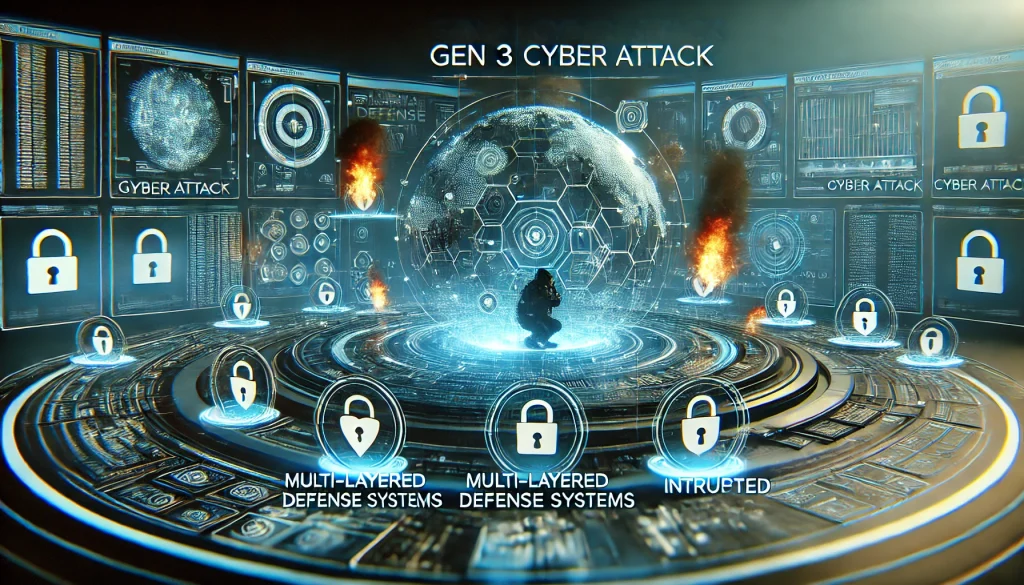
Overview
Cybersecurity is an ever-evolving field, and the threats we face are growing more sophisticated every year. This October 2024, one term on every cybersecurity expert’s radar is Gen 3 Cyber Attack. Third-generation cyber attacks are not just an evolution of previous methods but represent a more dangerous and complex threat model. This blog post delves into what makes Gen 3 cyber attacks particularly alarming, why they’re relevant now, and how they could impact businesses worldwide.
In the realm of cybersecurity, Gen 3 cyber attacks mark a distinct shift from earlier generations of cyber threats. First and second-generation attacks were largely concerned with viruses, bugs, and worms, such as the I Love You virus that plagued systems in the early 2000s. However, Gen 3 cyber attacks are much more complex, focusing on the manipulation of applications and programs rather than targeting network layers or simple bugs.
The relevance of these attacks has skyrocketed in recent months as businesses grapple with increasingly sophisticated malware and hacking attempts. As we move through October 2024, Gen 3 attacks are presenting new challenges to cybersecurity infrastructures globally. With their potential to manipulate trusted applications, these attacks can be devastating if preventive measures aren’t taken.
How Gen 3 Cyber Attacks Work?
Gen 3 cyber attacks are an escalation of earlier cyber threats. While traditional malware—such as the infamous I Love You virus—relied on spreading through vulnerabilities in operating systems, Gen 3 cyber attacks have shifted their focus to applications. These attacks involve taking control of legitimate software, exploiting the trust placed in these applications to gain unauthorized access or cause significant harm.
To understand how these attacks operate, consider how modern businesses rely heavily on cloud services, third-party applications, and software-as-a-service (SaaS) platforms. A Gen 3 cyber attack might, for example, compromise a widely-used SaaS platform, allowing the attacker to manipulate business-critical data. In this scenario, traditional firewalls and virus scanners are often ineffective, as the attack masquerades as routine program behavior, evading detection.
The rise in these types of attacks has been enabled by the rapid proliferation of interconnected systems. Many companies rely on a patchwork of third-party applications, increasing their attack surface. A single compromised app can grant attackers widespread access to business networks.
Examples of Gen 3 Cyber Attacks

One of the most prominent examples of a Gen 3 cyber attack in recent history was the 2020 SolarWinds hack. In this case, hackers manipulated a trusted software update for the SolarWinds platform, which was used by numerous government agencies and corporations. The result was catastrophic: the attackers gained long-term access to the systems of some of the most secure organizations globally.
Another case was the manipulation of Microsoft Exchange servers, where attackers infiltrated these widely-used email servers via application-layer vulnerabilities. By taking advantage of inherent trust in these applications, the attackers managed to exploit thousands of organizations, stealing sensitive data in the process.
These examples demonstrate how Gen 3 cyber attacks focus less on crashing systems and more on data extraction, surveillance, and long-term infiltration.
Impact of Gen 3 Cyber Attacks on Businesses
The implications of Gen 3 cyber attacks for businesses are immense. A successful attack can have far-reaching consequences, affecting not only the immediate operations but also the long-term viability of a company. The core difference between earlier cyber attacks and Gen 3 attacks lies in the stealth and persistence of the latter.
Businesses that fall victim to such attacks often face:
- Financial loss: From data theft to operational shutdowns, the financial implications are massive.
- Reputational damage: Trust is everything in today’s economy, and a successful attack can erode customer confidence.
- Legal repercussions: Many countries have strict data protection laws, and failing to prevent breaches could result in hefty fines.
Furthermore, the persistent nature of Gen 3 attacks means that businesses may not detect them until it’s too late. Unlike traditional viruses that often caused immediate damage (such as the I Love You virus, which quickly made itself known), Gen 3 cyber attacks aim for stealth. Attackers infiltrate systems, remain dormant, and then exploit their access when the time is right.
Prevention of Gen 3 Cyber Attacks

While the threat posed by Gen 3 cyber attacks is significant, prevention is not impossible. Businesses can take proactive measures to safeguard their systems:
- Application Monitoring: Continuous monitoring of applications can help detect unusual behavior early on. Intrusion detection systems tailored to application-layer threats are essential in identifying Gen 3 attack patterns.
- Patch Management: Ensuring that all software and applications are updated regularly reduces the risk of vulnerabilities being exploited.
- Zero Trust Security Model: This approach assumes that all applications, devices, and users are untrustworthy by default. Implementing the zero trust model requires constant authentication and validation for every access request.
- Employee Training: Cybersecurity awareness programs can empower employees to identify potential phishing attempts or suspicious software behavior before it escalates into a larger issue.
While these measures won’t completely eliminate the risk, they can significantly reduce the chances of a successful Gen 3 cyber attack.
The Future of Gen 3 Cyber Attacks
Looking ahead, the future of Gen 3 cyber attacks is closely tied to the development of technologies like artificial intelligence (AI) and machine learning (ML). As these technologies evolve, attackers will likely find new ways to exploit them. AI-driven attacks could potentially allow hackers to automate processes, making infiltration faster and more efficient.
On the other hand, defenders are also leveraging AI and ML to detect patterns in attack behavior. The cybersecurity landscape is becoming a battleground where both attackers and defenders use advanced technologies to outsmart one another.
Additionally, the rise of the Internet of Things (IoT) has broadened the attack surface for Gen 3 cyber attacks. As more devices become interconnected, the potential entry points for attackers increase. In the future, securing IoT devices will be just as crucial as securing traditional networks and applications.
Conclusion
Gen 3 cyber attacks represent a new frontier in the world of cybersecurity. These attacks, which focus on exploiting applications rather than networks, are both harder to detect and more dangerous than previous generations of threats. From the infamous I Love You virus to modern-day software manipulations, the evolution of cyber attacks has made the digital landscape more treacherous for businesses.
By understanding how these attacks work, examining real-world examples, and taking preventive steps, organizations can safeguard their data and systems. In the future, the cybersecurity industry will continue to innovate, developing new tools and strategies to counter increasingly sophisticated Gen 3 attacks. However, staying informed and vigilant remains the most effective defense.
Key Takeaways
- Gen 3 cyber attacks target trusted applications rather than network vulnerabilities.
- These attacks can cause financial, reputational, and legal damage to businesses.
- Prevention strategies include application monitoring, zero trust models, and patch management.
Resources
- CheckFirewalls. Preventing the Next Mega Cyber Attack
- Cyber Magazine. The Evolution of Cybersecurity
- Katz Blog. The Evolution of Cyber Threats
- Robotics Biz. Five Generations of Cyber Attacks in History
